Castell-y-Bere
OS Grid Ref:- SH 6608Located deep in the mountainous heart of mid-Wales, the highly picturesque ruins of Castell-y-Bere stand in an isolated spot in the Dysynni valley, near Llanfihangel-y-Pennant, ten miles south-west of Dolgellau. Perched dramatically high on its rocky outcrop in the shadow of Cadair Idris, this impressive fortress was strategically placed to guard an important pass into North Wales.
Castell-y-Bere was built by Llywelyn ap Iorwerth or Llywelyn the Great, Prince of Gwynedd in the thirteenth century to guard what was once a major route through the mountains. It was from Bere that Llywelyn journeyed south to meet with all the Welsh princes near the town of Machynlleth, to set up a governing body for Wales, he achieved this but it survived just a few years. Castell y Bere was strengthened by his grandson, Llywelyn the Last.
Castell-y-Bere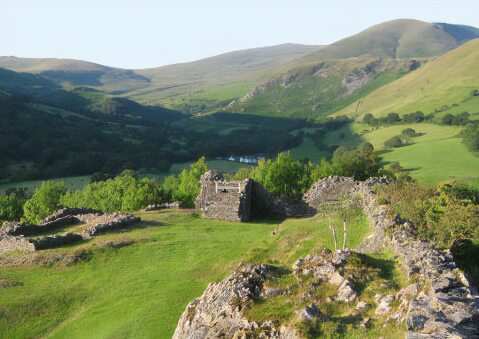
The shape of the castle is dictated by the shape of the rocky outcrop which it bestrides. At the north and south ends stand two typically Welsh D shaped towers. The north tower once contained a chapel on its first floor. A third rectangular tower at the highest point of the castle served as a keep. It was once protected by a system of ditches and drawbridges.
The castle was besieged during the Second Welsh War of Independence of 1282/83 by the central English Army under the command of King Edward I's Savoyard Lieutenant Sir Otto de Grandison. It fell, in April 1283 after which it was garrisoned by the English invaders. Castle y Bere was the last castle to fall during Edward I's military campaign against the Welsh. Realising the castle's strategic importance in his campaign to capture Wales, Edward refortified the castle. Castell y Bere was again attacked during a Welsh revolt by Madog ap Llywelyn in 1284, during which it was badly damaged, after which the castle was abandoned and fell into a state of disrepair.
Criccieth Castle
OS grid ref:- · SH505385Spectacular Criccieth Castle bestrides the headland between the small town of Criccieth's two beaches. Superb views of Cardigan Bay and the surrounding countryside can be had from the battlements.
Criccieth Castle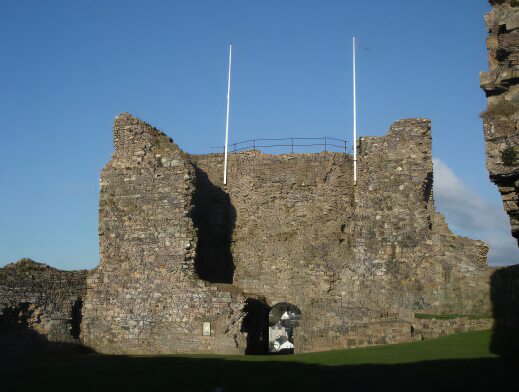
Criccieth's history is deeply entwined in the medieval conflict between Wales and England, built originally by the Welsh prince Llywelyn ap Iorwerth in the thirteenth century.
Llywelyn's illegitimate son Gruffydd ap Llywelyn was imprisoned in the castle by his half-brother, Dafydd, Prince of Gwynedd, before being handed over to Henry III of England, after which he was held in the Tower of London, Gruffydd later fell to his death in March 1244 while attempting an escape from the Tower by climbing down knotted sheets.
The building of Criccieth Castle was later continued by his grandson, Gruffydd's son, Llywelyn the Last, who added the now ruinous curtain wall, encompassing the entire promontory and forming the outer ward.
Criccieth Castle consists of a long triangular enclosure separated into three courtyards by its inner ward. An outer ward, guarded by walls and three towers was probably added by Llywellyn the Last. The massive twin-towered gatehouse is the castle's most dominating feature, and bears similarities to that of Beeston Castle, in the county of Cheshire.
The castle was captured by Edward I in 1283, during his second campaign against the Welsh and extensively refortified, during which a tower was adapted for use by a catapult and the walls, towers and gatehouse were probably heightened.
Ten years later, the castle underwent a lengthy siege, when Madog ap Llywelyn led a Welsh revolt against the English. The castle did not fall, however, as its strategic coastal location meant it could receive supplies by sea. In 1404 during the last major Welsh rebellion against English rule, it was captured by Owain Glyndwr, on this occasion, a French fleet prevented provisions and reinforcements arriving by sea, the garrison was forced to surrender and the castle burnt, the walls are still said to bear evidence of the scorching.
Criccieth Castle may also have given the name to the town rather than the other way round. Its suggested origins are 'crug caeth' - 'crug' (hill in Welsh), 'caith' (captives) - the name given to the jail on the hill, a function once held by the castle.
The artist J.M.W. Turner used the castle as a background in his famous painting of storm-wracked mariners.
A comprehensive on site exhibition relates the history of Gerald of Wales, there is also an exhibition on the castles of the Welsh princes.
Dolbadarn Castle
OS grid ref:- SH 5859Dolbadarn Castle is fairly regarded as one of the finest remaining castles of the native Welsh Princes. The castle stands on a rocky hill some eighty feet above Llyn Padarn and Llyn Peris in the Llanberis Pass and is listed as a World Heritage Site.
Dolbadarn Castle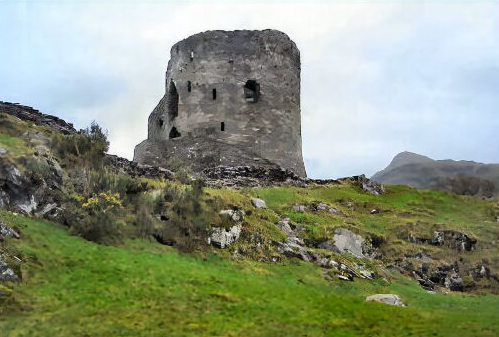
Constructed by the legendary Llywellyn the Great (Llywellyn ap Iorwerth) before 1230 to guard the main route through the Snowdonia mountain ranges, its position at the tip of Llyn Padarn allowed the garrison to blockade any movement through that part of the north.
The castle predates the English castles built by Edward I following his conquest of Wales. The 40' round tower built of slate and rubble, built on a rocky outcrop, once rose to three stories and houses a complex series of chambers. Inside the curtain wall stood a hall and a second tower.
The round tower measures 40 feet high, is 40 feet in diameter and possesses walls that are eight feet thick. Dolbadarn Castle, the spiral staircase in the Tower. Dolbadarn Castle's first-floor entrance was originally via a timber stair, the doorway of which was once defended by a portcullis and heavy bars.
Dolbadarn Castle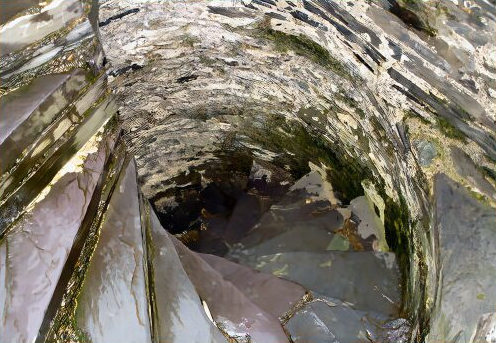
All traces of the interior floors have long since disappeared, victims of the neglect and pilfering which has taken place over the centuries, but beam holes to support the two main floor levels can still clearly be detected in the ruins of the tower. Both chambers possessed fireplaces. The basement would once have been accessed by a ladder through means of a trapdoor.
The battlements, from which there are excellent views of Llyn Padarn and the Llanberis Pass, can be reached by the unusual spiral stone staircase within the tower. Only low foundations of the outer buildings survive which once composed rectangular towers joined by a curtain wall and a large rectangular hall at the northern end of the site. There remain two open hearths inside where the hall once stood.
The castle remained inhabited after the demise of Llywelyn the Great in 1240 and according to John Leland, an Antiquarian who lived during the reign of Henry VIII, was used for the imprisonment of Owain ap Gruffydd by his younger brother Llywelyn the Last during their struggles for control of North Wales in the 1250s. The unfortunate Owain spent 20 years as a prisoner living on the upper floor of the castle. In 1282 Dolbadarn was captured by English armies led by the Earl of Pembroke and was abandoned two years later, its timber used by the English for the construction of Caernarfon Castle, after which it gradually fell into decay.
Dolwyddelan Castle
OS Grid Ref:- SH 7252Situated north of Blaenau Ffestiniog, and 5 miles southwest of the village of Betws-y-Coed, Dolwyddelan Castle stands proudly upon a crag that dominates its surroundings and is set against the rugged backdrop of dramatic Moel Siabod. The castle was founded by Iorwerth Trwydwn in around 1170. Dolwyddelan consists of two rectangular towers connected by a curtain wall. The keep and the curtain wall are said to have been built by Llywelyn ap Iorwerth. The views of the surrounding landscape from the top of the tower are spectacular.
Dolwyddelan Castle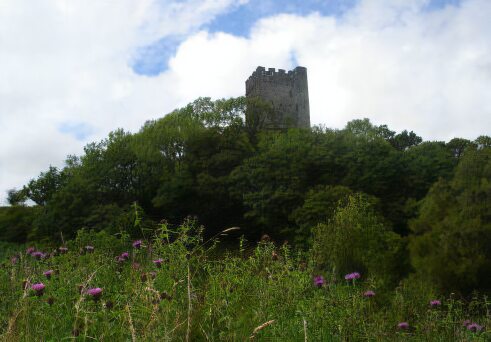
Dolwyddelan Castle is reputed to be the the birthplace of the renowned Llywelyn the Great, otherwise known as Llywelyn ap Iorwerth, who was born circa 1173, however, it seems highly unlikely that the castle even existed at this time. Archaeological excavations have unearthed the remains of an older castle which stands in the valley below Dolwyddelan. Situated on a small rocky knoll, and known as Tomen Castell, it is more likely that this is Llywelyn's birthplace. Today the mound or motte is covered with trees and vegetation but traces of a rectangular tower are discernable on the summit.
Dolwyddelan Castle itself was most probably built by Llywelyn the Great in the early part of the thirteenth century to guard the road into the heartland of his domain. The castle is defended by rock-cut ditches and sits upon a steep hill, it is dominated by a strong rectangular keep-tower, which was later heightened to three stories. Dolwydelan CastleDolwyddelan Castle remained an important stronghold for Llywelyn's grandson and successor, Llywelyn ap Gruffydd. The stark, square tower controlled a strategic pass from Merioneth to the Vale of Conway.
A stone curtain wall, enclosing a courtyard was added to the original keep in the thirteenth century. The castle fell to the invading forces of Edward I in 1283 and was restored, the second tower, which today stands in ruins, was probably added then. The fall of Dolwyddelan Castle marked a turning point of Edward's Welsh campaign, allowing the English army into the heartlands of Snowdonia. The Welsh built castle became a link in Edwards famous chain of strongholds around Gwynedd. English forces occupied the castle until 1290 when it eventually became irrelevant as the inland castle did not fit in with Edward's long term strategy of supplying his fortresses from the sea. By 1500, Dolwyddelan Castle had fallen into decay but was repaired in the nineteenth century by Lord Willoughby de Eresby. The distinctive battlements and projecting drains date from the time of this restoration. Dolwyddelan Castle is now in the care of CADW, on-site parking is provided and there is a site exhibition.
Ewloe Castle
OS grid ref:- SJ28826752Ewloe Castle, situated to the northwest of the town of Hawarden, was one of the last fortifications built by the Princes of Wales before the invasion of Wales by the English king, Edward I, its strategic position on a steeply-sloped promontory near the English border provides control of the road to Chester.
Ewloe Castle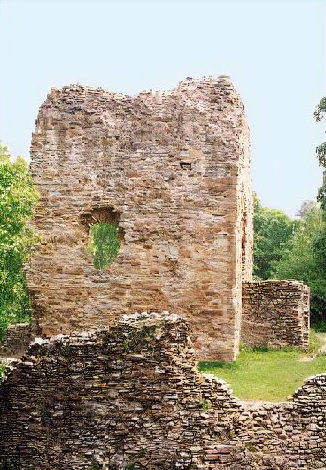
The castle consists of two courtyards with a D-shaped keep inside the triangular upper ward with a curtain wall. Ewloe Castle's D-shaped tower is unusual, normally they project from a curtain wall but at Ewloe the tower stands isolated in the middle of the upper ward surrounded by a curtain wall. At the western end of the outer ward is the ruin of a circular tower.
The castle is small and now stands in a very ruinous condition. The ruins the visitor sees today are those of the final stone fortification built by Llywelyn the Last. Its construction, which began in 1257, incorporated previous work undertaken by the earlier Welsh princes, Owain Gwynedd and Llywelyn the Great.
The fortified site had been established near to where Welsh forces had gained a victory over the English forces of King Henry II at the Battle of Ewloe in 1157.
A significant portion of the keep has now collapsed, but the south front still rises to its full original height. It is not so easy to date the keep, known as the Welsh Tower. It may be an earlier work of Llywelyn the Great, as its first-floor entrance is typical of the first Norman keeps, but later Llywelyn built conservative old fashioned square keeps such as the one at Dolforwyn Castle.
The tower contained a single apartment above a storage chamber, which was accessed only through a trapdoor. The outer walls rose higher than the two storeys to protect the roof from burning projectiles. On the parapet, the slots for hoarding are still discernable.
Dolforwyn Castle
Dolforwyn Castle is situated above the village of Abermule, in Powys. The castle was established by Llywelyn ap Gruffydd, Prince of Gwynedd, in the late thirteenth century. It stands on a wooded ridge and commands excellent views of the upper Severn Valley.
Dolforwyn Castle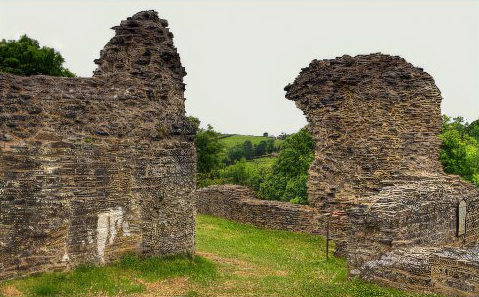
In an attempt to assert his claim as the most important of the Welsh Princes, Llywelyn ap Gruffydd needed to establish his authority in the strategic area now known as the Severn Valley, which gave access to the heartlands of Wales.
In 1257 he launched an invasion of the area and by 1263 he had taken the districts known as Cedewain and Ceri. This resulted in King Henry III of England recognising Llywelyn as Prince of Wales under the terms of the Treaty of Montgomery of 19 September 1267. To consolidate his newly conquered lands, Llywelyn ap Gruffydd constructed the Dolforwyn Castle between 1273 and 1277.
A rectangular platform was hewn from the rock which measured some 240 feet by 90 feet, the initial castle consisted of a rectangular keep at the southwest end of the platform and a circular tower at the opposing side. The two structures were connected by ramparts to form a rectangular-shaped enclosure with a D-shaped tower on the northern wall. The enclosed area was divided into two wards by a ditch. A two-storey structure was built against the north wall. The main gateway into the castle was on the west wall. A smaller entrance was sited in the south wall.
Soon after the completion of the castle, it was besieged by Roger Mortimer and Henry de Lacy, Earl of Lincoln. Dolforwyn Castle fell to the English on 8 April 1277. It was first given to Gruffydd ap Gwenwynwyn but was later granted to Roger Mortimer. The castle was modified by its new English owners, the south gate was blocked up, new buildings were constructed in the courtyard and it was provided with a well. After the death of Roger Mortimer in 1282, Dolforwyn Castle was inherited by his son Edmund Mortimer, the family estates were lost by his son Roger.
Gwenlian of Wales Previous Next Dafydd ap Gruffydd
